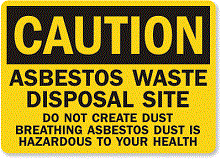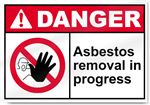Asbestos Products
The following are some of the typical products that may contain Asbestos:
- Asbestos cement building products such as flat and corrugated sheets and asbestos cement pipes – these products were extensively used in Queensland into the 1980s and of course are present in many homes today.
- Asbestos insulation products were frequently used in power stations and steam driven vessels. Asbestos insulation products began to be phased out and replaced with substitutes from about the late 1970s, however, they were extensively used in Queensland industrial installations prior to that.
- Friction materials such as brake and clutch linings – these products almost universally contained white asbestos or chrysotile.
- Electrical switchboard backing sheets.
- Floor tiles.
- Asbestos reinforced plastics
* Battery boxes.
* Asbestos millboard – used for insulating purposes including in air-conditioning systems.
* Woven asbestos products such as rope, cloth, tapes, gloves and many other items. - Fire doors.
 The list of products which contained asbestos, however is virtually endless and extreme care should be taken when working with or around any product that could potentially contain asbestos. If there is any uncertainty about whether a product contains asbestos it should be assumed that it does.
The list of products which contained asbestos, however is virtually endless and extreme care should be taken when working with or around any product that could potentially contain asbestos. If there is any uncertainty about whether a product contains asbestos it should be assumed that it does.
Much of the asbestos commercially used in Queensland was imported from South Africa or Canada although large quantities of asbestos were also mined in Australia at Wittenoom in Western Australia (where blue asbestos was mined) and in Northern New South Wales in mines at Baryugil and Barraba where white asbestos was mined.
For more information about asbestos safety and products, please contact AMAA on 0417 705 534 or via our online enquiry form.
Asbestos exposure in the home

Asbestos is still present in many homes and buildings today. This is because of the extensive use of asbestos in building materials, insulating materials and other products in the past.
The use of asbestos in some of these materials did not cease until well into 2003.
There have been countless incidents of persons being unwittingly exposed to asbestos carrying out home renovations or being present near homes or other building construction work. AMAA has worked tirelessly in recent years to raise awareness about exposure to asbestos and its dangers. It is the case that even brief exposure to asbestos can cause serious disease. All exposure should be avoided if possible.
10 facts about asbestos
When handling, treating or working with asbestos, here are 10 facts you should know about this hazardous material:
- Asbestos is a naturally occurring fibrous mineral commonly used in the construction industry from the 1920s through to the early 1980s. It was a popular choice by manufacturers and builders due to its fire resistance, sound absorption, strength and low electrical conductivity.
- There are two types of asbestos material. Bonded asbestos and friable asbestos. Bonded asbestos is solid and cannot be crumbled by hand. Friable asbestos is soft, and easily crumbles into dust.
- It is well known that the inhalation of asbestos fibres can cause serious and life-threatening illnesses including malignant lung cancer, mesothelioma, asbestosis, dust disease, as well as other asbestos related diseases.
- Due to the serious health risks involved, the manufacturing of asbestos in Australia was stopped by the 1990s, however it continues to be present in many buildings to this day particularly in forms of pipe and formwork.
- Prior to any renovations, inspections should be conducted on buildings constructed prior to 2003 in order to determine whether asbestos containing material is present. These inspections are important to identify if and where the asbestos is the home or building and what condition the asbestos is in.
- If the asbestos is in good condition and remains undisturbed, it can be manageable. However, if disturbed, asbestos releases microscopic fibres into the air that can be inhaled and may pose a serious health risk.
- Owners, land lords and operators of industrial and commercial buildings are legally obliged to survey their premises for the presence of asbestos.
- Any asbestos containing materials that deteriorate or becomes damaged should be repaired, or isolated by a licensed professional.
- Removal of asbestos containing material must be carried out by a licensed and qualified professional.
- All asbestos exposure should be avoided.
How can AMAA help you
For more information on the asbestos safety and safe handling of asbestos, please get in touch with the Asbestosis & Mesothelioma Association of Australia (AMAA) on 1800 017 758 or via our contact us form today.